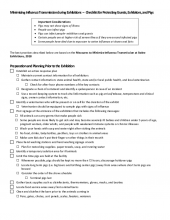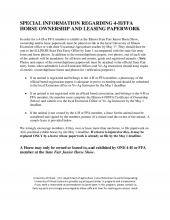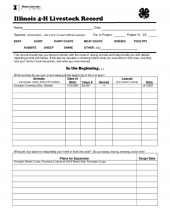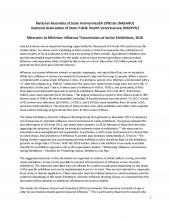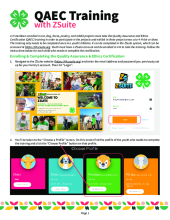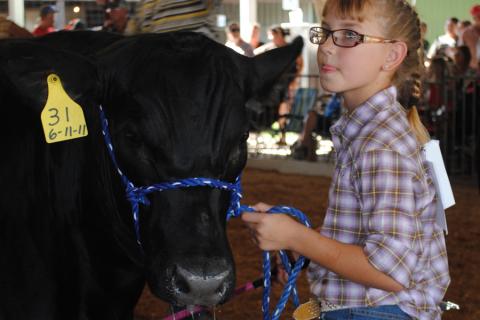
Members are required to take Quality Assurance and Ethics training when they sign up for horse, dog, cats, rabbits, and poultry projects.
Members enrolled in dairy and beef cattle, swine, sheep, and goats must take the Youth for the Quality Care of Animals certification annually. All 4-H exhibitors of these animals will be required to certify in the YQCA program each year starting for the 2022 show season. To view State 4-H Events, including Animal Sciences, visit our State Events Page.
Quality Assurance & Ethics Training
4-H members are required to take this online training when they sign up for horse, dog, cats, rabbits, and poultry projects. The Quality Assurance and Ethics training is required for youth in horses, rabbits, poultry, dogs and cats. You only need to take it once in your lifetime. Those who don’t complete the training will be removed from the animal science project and will not be eligible to exhibit at county fairs. This rule applies to 4-H members who exhibit live animals AND poster exhibits. The training can be completed in ZSuite, our 4-H enrollment system.
YQCA Requirement
Members enrolled in dairy and beef cattle, swine, sheep, and goats must take the Youth for the Quality Care of Animals certification annually. The YQCA is a new livestock quality assurance program that is replacing PQA which no longer exists. All 4-H exhibitors of these animals will be required to certify in the YQCA program each year starting for the 2022 show season. Attend either a face to face class or certify on-line. The YQCA program is for youth ages 8-21. The online version is broken into age divisions as follows: juniors 8-11, intermediate 12-14, senior 15-18, and young adults 19-21. This certification is needed each year with test out options of 1-3 years. Youth exhibiting swine at the Illinois State Fair and 4-H fairs are no longer required to be PQA plus certified. The estimated cost for the face-to-face training will be $3 and $12 for the online version.

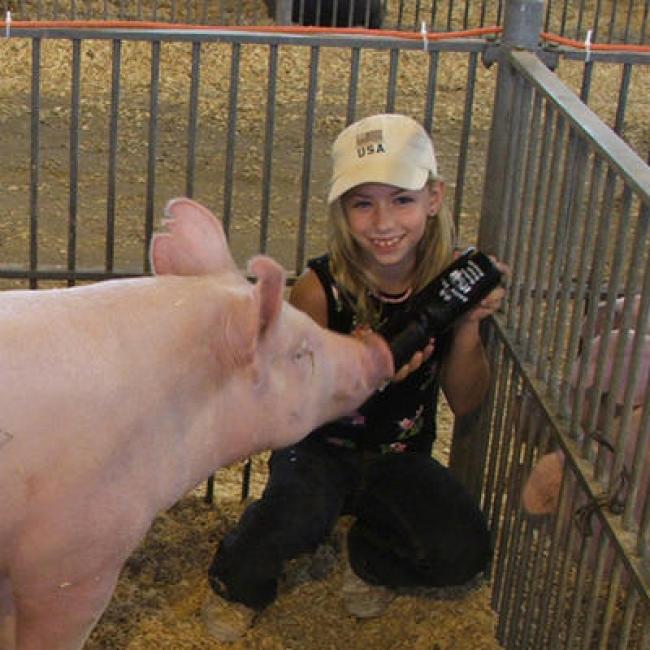
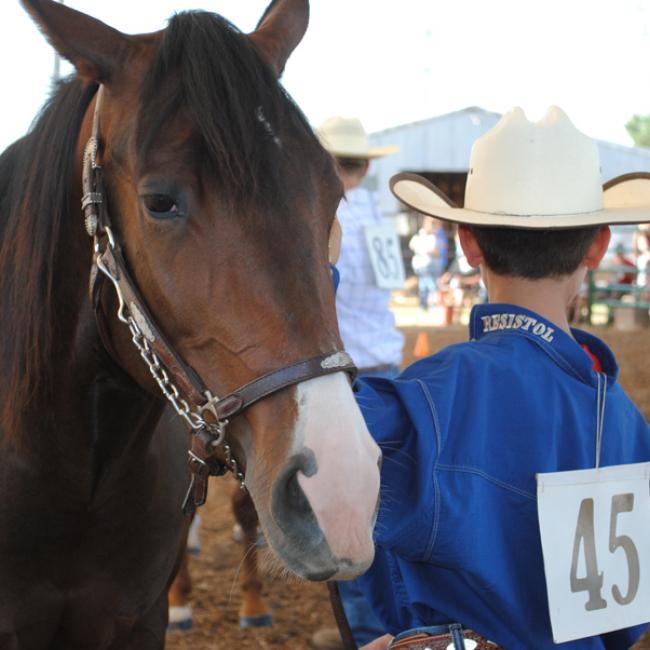
Discover the Power of the Illinois 4-H Livestock Pathway
Livestock Issues
State and Federal laws dictate the production and exhibition of livestock. Know what's required of you as an Illinois 4-H livestock producer and exhibitor.
Poultry Pullorum Test
The Illinois Department of Agriculture is again enforcing a clear pullorum test for all 4-H and county poultry in shows lasting longer than one day. The rule was suspended in 2018 due to a shortage of antigen. Be sure to allow adequate time and consult with your local veterinarian. This rule does not apply to waterfowl that normally swim, such as ducks and geese, per the county exhibition guidelines. 4-H and FFA shows lasting only one day are also exempt.
New FDA Antibiotic Rules Will Apply to Youth Livestock Exhibitors
For 4-H youth livestock exhibitors, parents and project advisors, Jan. 1, 2017, will usher in major changes in accessing medicated feeds for project animals. That’s when the U.S. Food and Drug Administration (FDA) will implement new rules, known as Guidance 209, for antibiotic use in all animals raised for food.
Antibiotics identified as medically important (to human health) will no longer be available for growth promotion purposes, including for 4-H show animals.
The use and distribution of antibiotics in animal agriculture is changing and producers of all sizes need to begin preparing to adapt in the coming year. Focusing on the one-health concept of combating antibiotic resistance, the United States Food and Drug Administration (FDA) is working to ensure the judicious use of humanly medically important antibiotics. Changes include eliminating the growth promotion use of human medically important antibiotics and expanding the list of feed-grade antibiotics classified as Veterinary Feed Directive (VFD) drugs. Historically, a majority of feed-grade antibiotics used in or on animal feeds have been available to producers over-the-counter, without approval from a veterinarian. By Jan. 1, 2017 the FDA will move all human medically important feed-grade antibiotics to the VFD drug process.
What does this mean for 4-H Youth Exhibiting Livestock?
Youth exhibitors and their families must work with a licensed veterinarian with whom they have an established veterinarian-client-patient relationship (VCPR) in order to receive permission to order and use feed containing a VFD drug. The veterinarian’s primary role is to advise and guide the producer (the client) in determining which medications are appropriate for their animals (the patients). This relationship must be established and recognized by the veterinarian prior to any VFD order being written. Feed distributors will require a valid VFD, provided by the veterinarian, prior to supplying customers with the regulated feed product. VFDs will need to be renewed every 6 months, based on renewal guidelines set by FDA.
Over-the-counter sales of medically important antibiotics administered in feed and water will end on or before January 1, 2017. Access to feed-grade antibiotics will require a veterinary feed directive (VFD) for a specific group of animals for a specific timeline as established by the herd veterinarian. Water medications will require a prescription.
Plan Now for Changes in Feed Purchases
4-H livestock exhibitors often have just a few animals and buy bagged feed from the local feed or farm supply store. With FDA’s new rules, these stores may no longer carry feed that exhibitors are used to buying. Exhibitors will need to contact a veterinarian if they don’t already have one and get a comprehensive health plan in place. This will include which antibiotics are needed to maintain good health along with other animal husbandry tools, such as biosecurity and vaccinations.
New Record-Keeping Rules Will Be Introduced
FDA’s new rules will usher in new record-keeping requirements for producers, including youth with 4-H livestock projects. Veterinarians who issue VFDs will need to keep the original form for two years. Youth exhibitors/parents/advisors also will need to keep a printed or electronic copy for two years.
Feed mills or distributors also will be required to keep a copy on file for two years. Water prescriptions will need to be kept for one year. All of these records must be made available to FDA on request.
Safety at Swine Exhibitions
Livestock shows are an important learning opportunity for thousands of 4-H and FFA youth across the United States. For these youth, exhibiting at their county or state fair represents the culmination of many months of work dedicated to the care and training of their animals. Agricultural exhibitions also provide meaningful opportunities for the public to learn about animal agriculture, observe animal behavior, and experience what it might be like to live on a farm. More than 150 million people visit agricultural fairs each year in North America.
Influenza can spread wherever animals or people congregate, and agricultural fairs are no exception. While rare, influenza A viruses can spread from people to pigs and from pigs to people. When a person is infected with a swine-origin influenza A virus, it is termed a variant virus infection, and denoted with a “v” after the subtype (e.g. H3N2v).
- (Note that the same virus when found in pigs does not carry the “v” denotation.) In the past 7 years, human cases of influenza A H1N1v, H1N2v, and particularly, H3N2v have been associated with exposure to swine at exhibitions. Between 2011 and 2017, 426 human H3N2v cases were reported from 18 states.
- The largest outbreak occurred in 2012 when a total of 309 human cases of H3N2v flu were identified, including 16 hospitalizations and one death.
- In 2017, a total of 67 variant virus infections (62 H3N2v, 1 H1N1v, and 4 H1N2v) were identified from 10 states (CDC, personal communication). The majority of these variant cases were exhibitors and others who reported close contact with pigs at agricultural fairs prior to their onset of illness.
The Swine Exhibitions Zoonotic Influenza Working Group first gathered in December 2012 to develop a set of measures to minimize influenza virus transmission at swine exhibitions. The group reviewed the document again in 2014 and 2015, and made minor updates. In 2016, because of important new data regarding the dynamics of influenza transmission between swine at exhibitions, 4-7 the measures for prevention were strengthened and augmented. In particular, a 2015 study by Bowman et al. found that at swine shows, the prevalence of influenza A-positive pigs increases substantially at 72 hours.8 This finding further supported the recommendation that exhibition swine should be kept on the exhibition grounds no longer than 72 hours.
Download the fact sheets below.
Horses
4-H Horse projects and activities provide an interactive, hands-on way for youth to explore raising and showing horses while developing life skills. These projects are designed to provide you an opportunity to handle, care for, and ride horses, as well as learn about the equine industry. 4-H members may own or lease a horse for this project. Many activities do not require the member to own a horse. There are many ways you can get involved:
- Join a club near you and enroll in a 4-H horse project.
- Test your equine management knowledge and compete in 4-H Hippology Contests.
- Join a team and compete in the 4-H Horse Bowl Contest.
- Speak up and compete in the 4-H Horse Speaking Contest.
- Practice riding and compete in a 4-H Horse Show.
Horse Lease/Ownership Form
Youth exhibiting horses at the Illinois State Fair Junior Horse Show must complete a Horse Lease/Ownership Form and submit it to the state fair by June 1. Many counties also require this ownership paper and often have an earlier deadline of May 1. If you are in the horse project and exhibiting a horse, please check with your local Extension office. Form is available below.
County 4-H Horse Shows
Youth interested in exhibiting horses at their county 4-H Horse Show may find it helpful to review the Illinois 4-H Junior Horse Show Guidelines.
State Contests
There are several contests to test your equine skills. Check out the guidelines in the resource section below.
Regional Qualifying Contests
Only youth who qualify in a regional contest may compete in the state horse bowl and hippology contests. Here is a map of the regions. Contact your region for information on regional contest dates.
- Northwest region contact
- NE region contact
- Central region contact
- South region contact
